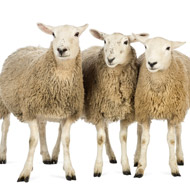
Low-lying areas of England most at risk
With temperatures set to rise this week, sheep farmers are being urged to check their local weather forecast and assess the risk of nematodirus to their lambs.
The warning comes from the Sustainable Control of Parasites in Sheep (SCOPS) Group, which says that the rapid change from the cold, wet winter to the forecast for the second half of April means a mass hatch of Nematodirus larvae is ‘highly likely’.
According to the SCOPS Nematodirus Forecast map, the areas most at risk are South and East England as well as most other low lying areas of England. SCOPS defines these areas at moderate risk, meaning they are within 10 days of a hatch.
“This poses a serious danger to February and March-born lambs grazing in fields that carried lambs last spring,” explained Lesley Stubbings of SCOPS. “With such a challenging season to date, we are urging sheep farmers to check their nearest weather station on the website and assess the risk to their lambs.”
Lesley adds that reports of early cases highlight the variation in hatch from farm to farm. As such, farmers are encouraged to take this variation into account when deciding whether or not they need to act.
“Not only should they assess the risk to a group of lambs based on the history of the field, but also its aspect and altitude,” said Dr Hannah Vineer, who was instrumental in developing the online forecast. “South-facing fields tend to have an earlier hatch and, as a guide, every 100m increase in altitude will delay hatching by about seven days.”
One vet who has already spotted signs of nematodirus is Harriet Fuller from Hertfordshire. “I have seen evidence of infection on several farms this week and I would urge sheep farmers to keep a close eye on the forecast for their area and talk to their vet for advice on the local situation,” she said.



 FIVP has shared a survey, inviting those working in independent practice to share their views on the CMA's proposed remedies.
FIVP has shared a survey, inviting those working in independent practice to share their views on the CMA's proposed remedies.